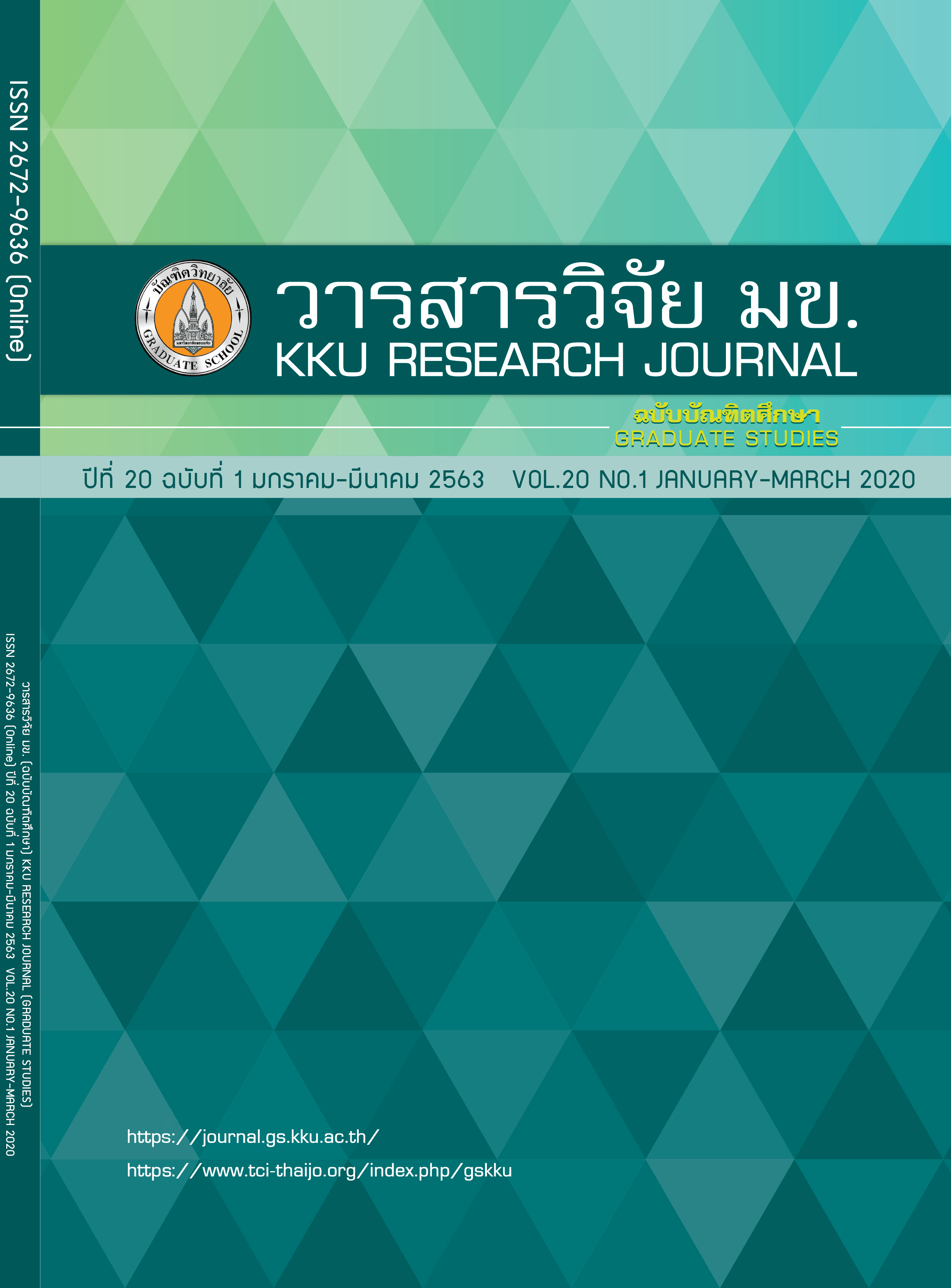Optimization of Lignin Degradation to Phenol Using Wet Oxidation Under Mild Condition
Keywords:
lignin, wet oxidation, phenolAbstract
The optimal condition for a lignin degradation to phenol using wet oxidation reaction was evaluated using response surface methodology with a set of experiment designed by Box-Behnken method. The concentration of produced phenol was set as the response and the effects of three operating parameters; the reaction temperature (140-180ºC), the sodium hydroxide concentration (4-20 g/l), and the initial of air pressure (2-8 bar), on phenol production were studies. The experimental data was fit well with a quadratic equation with high accuracy (R2 =97.33%). It has been found that all three factors interacts to each other. An increase of pressure yielded the high concentrations of acid compounds and less produced phenol in the products, however, the increase of sodium hydroxide gave the higher concentration of produced phenol. The high concentration of sodium hydroxide may catalyze the degradation of ether bonds but may not dispatch an aromatic ring. In case of the effect of the reaction temperatures, the results showed that the low temperature gave high formation of aromatic aldehydes, however the high temperature might cause the further oxidation of produced phenol to form other products. From the response surface methodology, the optimal condition for degradation of lignin to phenol was predicted at the reaction temperature of 163 °C, the amount of sodium hydroxide of 15.4 g/l, and the initial air pressure of 2 bar that could be claimed as mild condition. The average phenol concentration yielded under that condition was 23.4 ± 1 mg/l. Thus, this mild condition can be used for developing the phenol production process.
References
Bhalla Y, Gupta VK, Jaitak V. Anticancer activity of essential oils: A review. Int J Sci Food Agric. 2013;93(15):3643–3653.
Bloomfield SF, Miller EA. A comparison of hypochlorite and phenolic disinfectants for disinfection of clean and soiled surfaces and blood spillages. Int J Hosp Infect. 1989;13(3):231–239.
Freeman C, Ostle NJ, Fenner N, Kang H. A regulatory role for phenol oxidase during decomposition in peatlands. Soil Biol Biochem. 2004;36(10):1663–1667.
Martillanes S, Rocha-Pimienta J, Cabrera-Bañegil M, Martín-Vertedor D, Delgado-Adámez J. Application of Phenolic Compounds for Food Preservation: Food Additive and Active Packaging. Phenolic Compd - Biol Act. 2017;
Pilato L. Phenolic resins: A century of progress. Phenolic Resins A Century Prog. 2010;1–545.
Zou C, Zhao P, Ge J, Li J, Yu L, Qiu J, et al. Recycling of valuable chemicals through the catalytic decomposition of phenol tar in cumene process. Int J Process Saf Environ Prot. 2013;91(5):391–396.
Jiang W, Lyu G, Wu S, Lucia LA. Near-critical water hydrothermal transformation of industrial lignins to high value phenolics. Int J Anal Appl Pyrolysis. 2016;120:297–303.
Yoshikawa T, Shinohara S, Yagi T, Ryumon N, Nakasaka Y, Tago T, et al. Production of phenols from lignin-derived slurry liquid using iron oxide catalyst. Appl Catal B Environ. 2014;146:289–297.
Naseem A, Tabasum S, Zia KM, Zuber M, Ali M, Noreen A. Lignin-derivatives based polymers, blends and composites: A review. Int J Biol Macromol. 2016;93:296–313.
Ksibi M, Ben Amor S, Cherif S, Elaloui E, Houas A, Elaloui M. Photodegradation of lignin from black liquor using a UV/TiO2 system. Int J Photochem Photobiol A Chem. 2003;154(2–3):211–218.
Hashmi SF, Meriö-Talvio H, Hakonen KJ, Ruuttunen K, Sixta H. Hydrothermolysis of organosolv lignin for the production of bio-oil rich in monoaromatic phenolic compounds. Int J Fuel Process Technol. 2017;168:74–83.
Fernández-Rodríguez J, Erdocia X, Sánchez C, González Alriols M, Labidi J. Lignin depolymerization for phenolic monomers production by sustainable processes. Int J Energy Chem. 2017;26(4):622–631.
Yoshikawa T, Yagi T, Shinohara S, Fukunaga T, Nakasaka Y, Tago T, et al. Production of phenols from lignin via depolymerization and catalytic cracking. Int J Fuel Process Technol. 2013;108:69–75.
OUYANG X, TAN Y, QIU X. Oxidative degradation of lignin for producing monophenolic compounds. Int J Fuel Chem Technol. 2014;42(6):677–682.
Ye Y, Zhang Y, Fan J, Chang J. Novel Method for Production of Phenolics by Combining Lignin Extraction with Lignin Depolymerization in Aqueous Ethanol. Int J Ind Eng Chem Res. 2012;51:103–110.
Degradation of Lignin to High Value-Added Compounds Using Hydrothermal Method Over Ni / Al2O 3 Catalyst. KKU Res J. 15(4):36–44.
Boupan M, Neramittagapong A, Kumsaen T, Neramittagapong S. Optimization of Dimethyl Ether Synthesis from Methanol over Co Supported on Diatomite Catalyst by Response Surface Method ( RSA ). KKU Res J. 2017;17(4).
Kang S, Li X, Fan J, Chang J. Hydrothermal conversion of lignin: A review. Renew Sustain Energy Rev. 2013;27:546–558.
Aarabi A, Mizani M, Honarvar M. The use of sugar beet pulp lignin for the production of vanillin. Int J Biol Macromol. 2017;94:345–354.
Ouyang X, Ruan T, Qiu X. Effect of solvent on hydrothermal oxidation depolymerization of lignin for the production of monophenolic compounds. Int J Fuel Process Technol. 2016;144:181–185.
Roberts VM, Stein V, Reiner T, Lemonidou A, Li X, Lercher JA. Towards quantitative catalytic lignin depolymerization. Chem - A Eur J. 2011;17(21):5939–5948.



